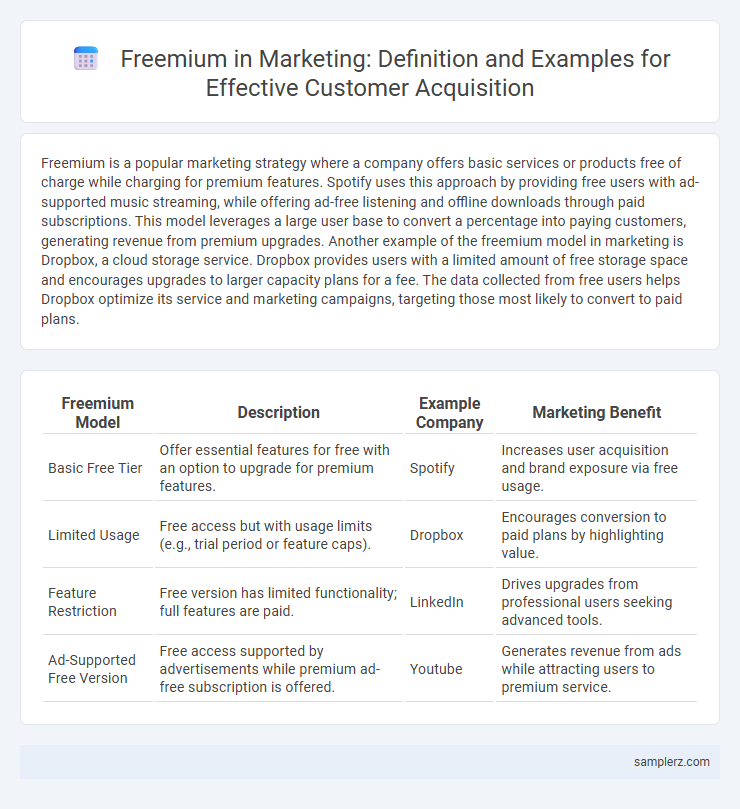Freemium is a popular marketing strategy where a company offers basic services or products free of charge while charging for premium features. Spotify uses this approach by providing free users with ad-supported music streaming, while offering ad-free listening and offline downloads through paid subscriptions. This model leverages a large user base to convert a percentage into paying customers, generating revenue from premium upgrades. Another example of the freemium model in marketing is Dropbox, a cloud storage service. Dropbox provides users with a limited amount of free storage space and encourages upgrades to larger capacity plans for a fee. The data collected from free users helps Dropbox optimize its service and marketing campaigns, targeting those most likely to convert to paid plans.
Table of Comparison
| Freemium Model | Description | Example Company | Marketing Benefit |
|---|---|---|---|
| Basic Free Tier | Offer essential features for free with an option to upgrade for premium features. | Spotify | Increases user acquisition and brand exposure via free usage. |
| Limited Usage | Free access but with usage limits (e.g., trial period or feature caps). | Dropbox | Encourages conversion to paid plans by highlighting value. |
| Feature Restriction | Free version has limited functionality; full features are paid. | Drives upgrades from professional users seeking advanced tools. | |
| Ad-Supported Free Version | Free access supported by advertisements while premium ad-free subscription is offered. | Youtube | Generates revenue from ads while attracting users to premium service. |
Understanding Freemium in Marketing
Freemium in marketing involves offering basic services or products for free while charging for premium features or enhanced experiences, effectively attracting a broad user base. Popular examples include Spotify, which provides free music streaming with ads and charges for ad-free, offline listening, and LinkedIn, offering free networking tools alongside paid premium subscriptions with advanced insights. This model drives user engagement and conversion by lowering entry barriers and showcasing value before upselling premium offerings.
Key Characteristics of Freemium Models
Freemium marketing models offer a basic service or product for free while charging for premium features, driving user acquisition and engagement without initial cost barriers. Key characteristics include a clear distinction between free and paid tiers, scalable user base growth, and seamless upselling strategies that highlight added value. Successful freemium approaches rely on balancing user satisfaction in the free version with compelling incentives to upgrade.
Benefits of Using Freemium Strategies
Freemium marketing strategies, such as those used by Spotify and Dropbox, offer core services for free while charging for premium features, enhancing customer acquisition and engagement. This approach reduces entry barriers, encourages large user bases, and fosters brand loyalty by allowing users to experience value before committing financially. Data shows that companies employing freemium models can achieve higher conversion rates, with up to 10% of free users upgrading to paid plans, driving sustainable revenue growth.
Popular Freemium Marketing Examples
Spotify exemplifies freemium marketing by offering free access to music with ads, encouraging users to upgrade to premium for an ad-free experience and offline listening. LinkedIn uses a freemium model by providing basic networking features at no cost while charging for premium tools like InMail and advanced analytics. Dropbox attracts users with free cloud storage and charges for additional space and enhanced collaboration features, driving conversions through tiered service options.
Freemium Success Stories in SaaS
Freemium success stories in SaaS include companies like Dropbox, which grew its user base exponentially by offering free cloud storage with optional paid upgrades for enhanced capacity and features. Spotify leveraged freemium by providing free music streaming supported by ads, converting millions of users to premium subscriptions for ad-free listening and offline access. Slack's freemium model enabled teams to use basic messaging and collaboration tools at no cost, driving widespread adoption that fueled upgrades to paid plans with advanced integrations and administrative controls.
Freemium in Mobile Apps: Case Studies
Mobile apps use the freemium model by offering free basic features while charging for premium upgrades, enhancing user acquisition and revenue streams. Spotify exemplifies this approach by providing free streaming with ads and limited skips, encouraging users to subscribe for ad-free listening and offline access. Another case is Dropbox, which offers free storage space to attract users and monetizes through paid plans with expanded storage and advanced collaboration tools.
How Freemium Drives Customer Acquisition
Freemium models drive customer acquisition by offering basic features at no cost, enticing users to engage with the product without financial barriers. This strategy builds a large user base quickly and provides opportunities for upselling premium features. Companies like Spotify and Dropbox leverage freemium to convert free users into paying customers through enhanced value propositions and targeted marketing.
Challenges of Freemium Marketing
Freemium marketing faces significant challenges such as converting free users into paying customers while maintaining service quality. High acquisition costs combined with low conversion rates can strain resources and reduce profitability. Balancing feature offerings to satisfy free users without undermining the premium tier requires strategic segmentation and continuous value optimization.
Transitioning Users from Free to Paid Plans
Freemium marketing strategies encourage users to experience core features at no cost while highlighting premium functionalities that enhance value and productivity. Companies like Spotify use personalized playlists and offline listening as incentives for free users to upgrade to paid subscriptions. Clear differentiation between free and paid tiers, coupled with time-limited offers and exclusive content, effectively drives conversion rates from free trials to committed customers.
Tips for Implementing Freemium in Your Marketing Strategy
Offering a freemium model allows businesses to attract a wider audience by providing basic features for free while encouraging upgrades to premium services. To implement this effectively, focus on clearly communicating the value of premium features, using data-driven insights to optimize user experience, and incorporating targeted calls-to-action that guide free users toward conversion. Monitoring user behavior and continuously refining the pricing tiers can enhance customer retention and maximize revenue growth.

example of freemium in marketing Infographic
 samplerz.com
samplerz.com